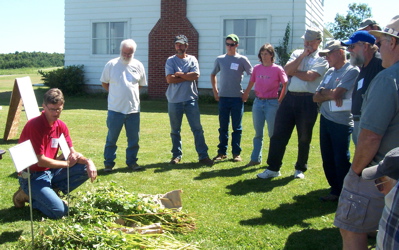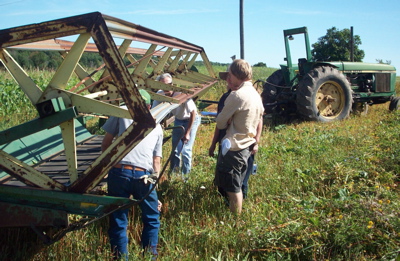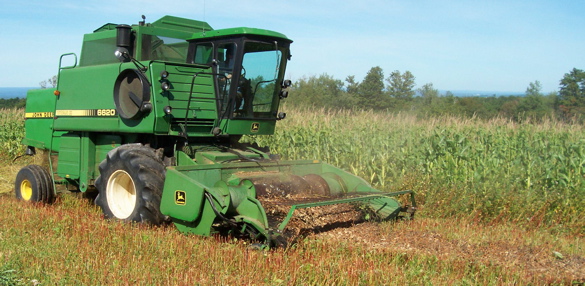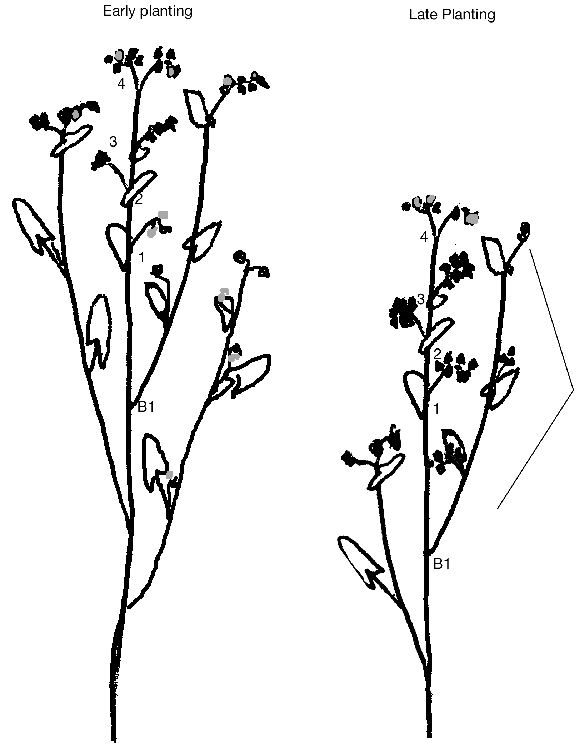Northeast Buckwheat Growers Newsletter
No. 26 September 2008
Edited by Thomas Bjorkman, Cornell NYSAES, Geneva NY
2008 Field Day
The field day this year was held at Pete Gianforte’s farm in Madison County, with a new co-sponsor in NOFA-NY.
It was a beautiful sunny day, with clear views of Oneida Lake, Tug Hill, and the Mohawk Valley. The famed windmills of Fenner were on the next ridge to the east, and Turning Stone easily spotted beyond them.
Attendees had varying buckwheat-raising experience, from one planning on doing up to an acre of cover crop next year to Ted Carley, who has raised 100 acres a year since about 1940. With that much diversity, attendees had many opportunities to learn new things from each other. The program included discussion of various production decisions. The effect of daylength on seed set and maturation was new to many. Thanks Pete for being a great host!
Pictured: Field day participants compare seed production on buckwheat that was planted on various dates.
Organic buckwheat. Elizabeth Dyck of NOFA-NY discussed what makes organic buckwheat different from conventional when neither is sprayed with pesticides. Organic buckwheat is produced on farms that are using organic practices throughout, with buckwheat contributing to a production system that allows the grower to forego synthetic pesticides and fertilizers elsewhere in the rotations. It is also part of the organic market that sustains those devoted to playing roles as growers, purveyors and consumers.
The Gianforte farm has been certified by NOFA-NY for many years.
Dr. Dyck’s long experience studying buckwheat production and its use as a cover crop made her a sought-after resource all day.
Swathing. The swathing demonstration was a big draw. Pete had sown buckwheat as a cover crop in late May, and it was mature enough to swath about 10 days before the field day. Those swaths had dried down nicely for the field day. A quick drive with the swather showed how he could cut 25 feet at a good speed. A combine’s speed is usually limited by how quickly the leaves and stalks can clear the screens. No such limit here. Also, it doesn’t take a particularly big tractor to do the cutting. 
Pictured: This is Pete Gianforte’s 25-foot swather. They were really into equipment!
The dried swaths got attention next. Pete had a pickup head on his combine, which rolled the windrow nearly intact into the maw of the machine. The leaves were completely dry, so they crumbled out of the way quickly, and the stems had toughened up to pass straight through the combine. That let Pete run the combine quickly across the field without worrying about clogging. The grain came out of the bin clean, the loss on cleaning would only have been a few percent even without adjusting the combine. The moisture was estimated by observers to be in the 14% range. (We didn’t have a moisture meter, so that number may not be all that accurate.)

There are pictures and clips of this activity under the How-to-harvest tab of the online buckwheat production guide.
Day length and buckwheat harvest
Judging when to harvest buckwheat can be tricky. In the Northeast, we have an advantage over more northerly growers because the day length and cool nights combine to encourage ripening of the crop at just the right time.
Buckwheat usually flowers about the fifth node. The nodes are where leaves come out, sometimes followed either by flower clusters or by branches. At first, there is a flower cluster at each node (numbered 1, 2, 3, 4 below, in order of appearance). Then lower nodes start to make branches, beginning with the one just below the first cluster (B1).
If planted early, the long day length during seed set causes the plant to set fewer seeds on the first flowering nodes. (See left plant below.) Most of the crop is close to the top of the plant. But there are also old seeds low on the plant that may fall off before harvest. The varying maturity makes these plants hard to direct combine. There are shattering seeds, ripe seeds and green seeds at the same time.
Normally, buckwheat is planted late, about July 4. The shorter days in August increase seed set at those early nodes. (See right plant below.) Later nodes, which are higher on the plant, may have only unripe and empty kernels when the main crop is ready to harvest. A strong early set causes the plant to divert energy to filling the first fruit uniformly. Looking only at the top of the plant can be very misleading.
 When inspecting plants to see whether they are ready to harvest, make a point of looking down in the canopy to see where the bulk of the crop is set.
When inspecting plants to see whether they are ready to harvest, make a point of looking down in the canopy to see where the bulk of the crop is set.
In this drawing, the leaves have fallen off the lower nodes as harvest approaches. That doesn’t always happen by the time the grain is ripe. It’s not necessary to cut near ground level to get all the grain. Cutting high reduces the amount of juicy stem moving across the screens.
Left: planting date affects where the seeds are. Shorter days in mid-August cause more seed set on early nodes and more-concentrated maturity. Immature grains are drawn in gray.
Season observations
As usual, some parts of the Northeast have had every kind of weather imaginable. In general, New York ran wet and Pennsylvania dry.
In Central New York, it seemed to rain every day in July and much of August. However, it tended to be a little at a time. That even moisture was very good for growing buckwheat.
One grower put buckwheat on a piece of rented land that has rather hard soil overall and a plow pan, with low spots and knolls spread throughout the field. Usually, fields like that are a disaster with buckwheat. The hard soil is difficult for the fine roots to penetrate, and the plow pan impossible. With an undersized root system, the plants dry out after a few days without rain. Even faster on the knolls. When it rains a lot, the plants in the low spots drown, and the rest lose roots that get waterlogged near the plow pan.
But this year’s regular showers kept the soil soft enough to penetrate, and supplied water every couple of days but never flooded. The crop looks really nice.
In early August, nights started cooling off a couple weeks earlier than usual. This encouraged the buckwheat plants to mature the crop sooner as well. Even in early September, many fields are getting close to swathing maturity.
On the other hand, those cool nights bring morning fog. The first two weeks of August are usually when most of the crop is pollinated. But flowers wet from fog don’t open. Once the sun comes out, they open, but can get filled with a dewdrop, which gets in the way of the pollinator. The resulting poor pollination is most likely to be a problem in the bottom of valleys.
